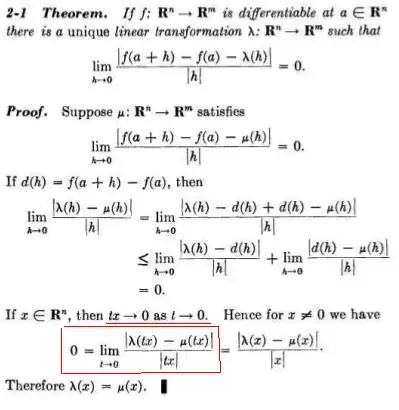Suppose we know that $\displaystyle \lim_{h \to 0} F(h) = 0$. This means that for every $\epsilon > 0$, there exists $\delta > 0$ such that
$$|h| < \delta \implies |F(h)| < \epsilon.$$
Fix $x \in \mathbb{R}^n$. If $|t| < \delta/|x|$, then $|tx| = |t||x| < \delta$, so $|F(tx)| < \epsilon$. This says exactly that $\displaystyle \lim_{t \to 0} F(tx) = 0$.
In your situation, take
$$F(h) := \frac{|\lambda(h) - \mu(h)|}{|h|}.$$
Edit: If $\displaystyle \lim_{h \to h_0} F(h) = L$ and $\displaystyle \lim_{t \to t_0} g(t) = h_0$, then $\displaystyle \lim_{t \to t_0} F(g(t)) = L$.
Proof: Fix $\epsilon > 0$. By the first limit hypothesis, there exists $\delta_1 > 0$ such that
$$|h - h_0| < \delta_1 \implies |F(h) - L| < \epsilon$$
By the second limit hypothesis, there exists $\delta_2 > 0$ such that
$$|t - t_0| < \delta_2 \implies |g(t) - h_0| < \delta_1.$$
Therefore, if $|t - t_0| < \delta_2$, then $|F(g(t)) - L| < \epsilon$. This says exactly that $\lim_{t \to t_0} F(g(t)) = L$.
Remark: Note that no continuity hypotheses were necessary. A continuity hypothesis on $F$ would be needed to show instead that $\displaystyle \lim_{t \to t_0}F(g(t)) = F(h_0)$.
